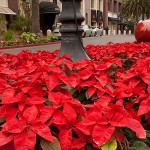All about poinsettias
December 14, 2012 @ 11:00 am

Photo by JKehoe_Photos via Creative Commons License.
What popular holiday plant goes by the name Cuitlaxochitl, Flower of the Holy Night, or Crown of the Andes, and has even been referred to as lobster flower or flame-leaf flower? If you guessed poinsettia, you’re right.
In the U.S., poinsettias got their name from a botanist and the first U.S. ambassador to Mexico, Joel Roberts Poinsett, who introduced the plant into the country in 1828. But its history goes back many centuries, according to this terrific reference guide from the University of Illinois Extension. The Aztects called these bright red plants Cuitlaxochitl. They used the sap to control fevers and the leaves to make a reddish dye during the 14th through 16th century.
Poinsettias are part of the Euphorbiaceae or Spurge family. Botanically, the plant is known as Euphorbia pulcherrima. The U of Illinois experts also dispense with a myth, noting that poinsettias are NOT poisonous. It notes that an Ohio State University study showed that a 50-pound child would have to eat more than a pound-and-a-quarter of Poinsettia leaves (500 to 600 leaves) to have any side effects. The most common side effects that have been reported from Poinsettia ingestions are upset stomach and vomiting. The leaves are reportedly not very tasty, so it’s highly unlikely that kids or even pets would be able to eat that many!
Here are some tips on how to care for your poinsettia. Poinsettias can last up to 6-8 weeks if properly cared for:
_ Make sure it is wrapped properly because exposure to low temperatures even for a few minutes can damage the bracts and leaves.
_ Keep in indirect light. Six hours of light daily is ideal. Keep the plant from touching cold windows.
_ Keep them away from radiators, air registers or open doors and windows.
_ Punch a few holes in the foil so water can drain through into a saucer. Water when the soil is dry.
Reference: The University of Illinois Extension Poinsettia Pages.
Filed under Seattle Landscape Maintenance Permalink · No Comments »



